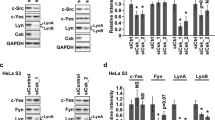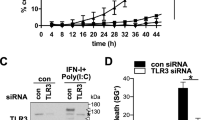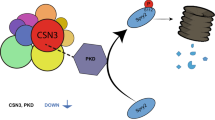Abstract
3Y1 rat fibroblasts overexpressing the tyrosine kinase c-Src (3Y1c-Src cells) become transformed by downregulation of protein kinase C δ (PKC δ). However, when 3Y1c-Src cells were subjected to serum withdrawal, they underwent apoptosis via a cytochrome c/caspase 9 pathway. In contrast, neither parental nor v-Src-transformed 3Y1 cells underwent apoptosis when subjected to serum withdrawal. If PKC δ was downregulated, the apoptotic phenotypes induced by serum withdrawal in the 3Y1c-Src cells were suppressed. The apparent survival signal generated by PKC δ downregulation was independent of the phosphatidylinositol-3-kinase (PI3K)/Akt survival pathway. Collectively, these data indicate that (1) c-Src overexpression renders cells sensitive to apoptotic stress, and (2) that downregulation of PKC δ provides a novel PI3K/Akt-independent survival signal capable of suppressing apoptotic signals.
This is a preview of subscription content, access via your institution
Access options
Subscribe to this journal
Receive 50 print issues and online access
$259.00 per year
only $5.18 per issue
Buy this article
- Purchase on Springer Link
- Instant access to full article PDF
Prices may be subject to local taxes which are calculated during checkout






Similar content being viewed by others
References
Biscardi JS, Belsches AP, Parsons SJ . 1999 Mol. Carcinog. 21: 261–272
Blake RA, Garcia-Paramio P, Parker J, Courtneidge SA . 1999 Cell Growth Differ. 10: 231–241
Budihardjo I, H. Oliver H, Lutter M, Luo X, Wang X . 1999 Annu. Rev. Cell Dev. Biol. 15: 269–290
Cressman C, Mohan PS, Nixon RA, Shea TB . 1995 FEBS Lett. 367: 223–227
Daigo Y, Furukawa Y, Kawasoe T, Ishiguro H, Fujita M, Sugai S, Nakamori S, Liefers GJ, Tollenaar RA, van de Velde CJ, Nakamura Y . 1999 Cancer Res. 59: 4222–4224
Datta SR, Dudek H, Tao X, Masters S, Fu H, Gotoh Y, Greenberg ME . 1997 Cell 91: 231–241
Datta SR, Brunet A, Greenberg ME . 1999 Genes Dev. 13: 2905–2927
Davies SP, Reddy H, Caivano M, Cohen P . 2000 Biochem. J. 351: 95–105
Dotto GP, Parada LF, Weinberg RA . 1985 Nature 318: 472–475
Evan GI, Wyllie AH, Gilbert CS, Littlewood TD, Land H, Brooks M, Waters CM, Penn LZ, Hancock DC . 1992 Cell 69: 119–128
Evan G, Littlewood T . 1998 Science 281: 1317–1322
Green DR . 1998 Cell 94: 695–698
Gschwendt M, Muller H-J, Kielbasa K, Zang R, Kittstein W, Rincke G, Marks F . 1994 Biochem. Biophys. Res. Comm. 199: 93–98
Hahn WC, Counter CM, Lundberg AS, Beijersbergen RL, Brooks MW, Weinberg RA . 1999 Nature 400: 464–468
Hakak YY, Hsu YS, Martin GS . 2000 Oncogene 19: 3164–3171
Hanahan D, Weinberg RA . 2000 Cell 100: 57–70
Hirai S, Izumi Y, Higa K, Kaibuchi K, Mizuno K, Osada S, Suzuki K, Ohno S . 1994 EMBO J. 13: 2331–2340
Hornia A, Lu Z, Sukezane T, Zhong M, Foster DA . 1999 Mol. Cell. Biol. 19: 7672–7680
Hueber AO, Evan GI . 1998 Trends Genet. 14: 364–367
Irby RB, Mao W, Coppola D, Kang J, Loubeau JM, Trudeau W, Karl R, Fujita DJ, Jove R, Yeatman TJ . 1999 Nat. Genet. 21: 187–190
Irby RB, Yeatman TJ . 2000 Oncogene 19: 5636–5642
Johnson D, Agochiya M, Samejima K, Earnshaw W, Frame M, Wyke J . 2000 Cell Death Differ. 7: 685–696
Joneson T, Bar-Sagi D . 1999 Mol. Cell. Biol. 19: 5892–5901
Kandel ES, Hay N . 1999 Exp. Cell Res. 253: 210–229
Kauffmann-Zeh A, Rodriguez-Viciana P, Ulrich E, Gilbert C, Coffer P, Downward J, Evan G . 1997 Nature 385: 544–548
Kennedy SG, Wagner AW, Conzen SD, Jordan J, Bellacosa A, Tsichlis PN, Hay N . 1997 Genes Dev. 11: 701–713
Land H, Parada LF, Weinberg RA . 1983 Nature 304: 596–602
Lu Z, Hornia A, Jiang YW, Frankel P, Zang Q, Foster DA . 1997 Mol. Cell Biol. 17: 3418–3428
Lu Z, Liu D, Hornia A, Devonish W, Pagano M, Foster DA . 1998 Mol. Cell. Biol. 18: 839–845
Lu Z, Hornia A, Joseph T, Sukezane T, Frankel P, Zhong M, Bychenok S, Xu L, Feig LA, Foster DA . 2000 Mol. Cell. Biol. 20: 462–467
Odajima J, Matsumura I, Sonoyama J, Daino H, Kawasaki A, Tanaka H, Inohara N, Kitamura T, Downward J, Nakajima K, Hirano T, Kanakura Y . 2000 J. Biol. Chem. 275: 24096–24105
Pongracz J, Webb P, Wang K, Deacon E, Lunn OJ, Lord JM . 1999 J. Biol. Chem. 274: 37329–37334
Schuler M, Bossy-Wetzel E, Goldstein JC, Fitzgerald P, Green DR . 2000 J. Biol. Chem. 275: 7337–7342
Serrano M, Lin AW, McCurrach ME, Beach D, Lowe S . 1997 Cell 88: 593–602
Soltoff SP . 2001 J. Biol. Chem. 276: 37986–37992
Strasser A, O'Conner L, Dixit VM . 2000 Ann. Rev. Biochem. 69: 217–245
Wang NM, Yeh KT, Tsai CH, Chen SJ, Chang JG . 2000 Cancer Lett. 150: 201–204
Webb BL, Jimenez E, Martin GS . 2000 Mol. Cell. Biol. 20: 9271–9280
Zang Q, Lu Z, Curto M, Barile N, Shalloway D, Foster DA . 1997 J. Biol. Chem. 272: 13275–13280
Acknowledgements
We thank Steve Martin for communicating results prior to publication. The dominant negative PKC δ mutant was generously provided by Shigeo Ohno. We thank Dongming Cai and Rebecca James for comments on the manuscript. This investigation was supported by National Institutes of Health grant CA46677. Research Centers in Minority Institutions award RR-03037 from the National Center for Research Resources of the National Institutes of Health, which supports infrastructure and instrumentation in the Biological Sciences Department at Hunter College, is also acknowledged.
Author information
Authors and Affiliations
Corresponding author
Rights and permissions
About this article
Cite this article
Zhong, M., Lu, Z. & Foster, D. Downregulating PKC δ provides a PI3K/Akt-independent survival signal that overcomes apoptotic signals generated by c-Src overexpression. Oncogene 21, 1071–1078 (2002). https://doi.org/10.1038/sj.onc.1205165
Received:
Revised:
Accepted:
Published:
Issue Date:
DOI: https://doi.org/10.1038/sj.onc.1205165
Keywords
This article is cited by
-
Early Down-Regulation of PKCδ as a Pro-Survival Mechanism in Huntington’s Disease
NeuroMolecular Medicine (2014)
-
Opposite effects of protein kinase C beta1 (PKCβ1) and PKCε in the metastatic potential of a breast cancer murine model
Breast Cancer Research and Treatment (2009)
-
Suppression of cell migration by protein kinase Cδ
Oncogene (2005)
-
Alternative phospholipase D/mTOR survival signal in human breast cancer cells
Oncogene (2005)
-
Silencing of hdm2 oncogene by siRNA inhibits p53-dependent human breast cancer
Cancer Gene Therapy (2004)



